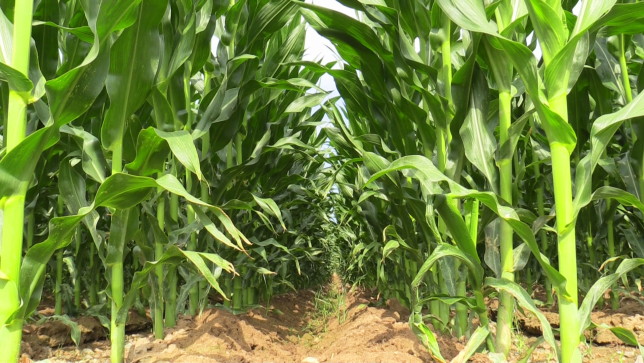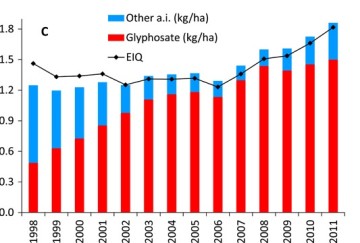According to new research from University of Virginia in the U.S., widespread adoption of genetically modified (GM) crops has decreased the use of insecticides, but increased the use of weed-killing herbicides as weeds become more resistant, leading to serious environmental damage.

Economist Federico Ciliberto led the largest study of genetically modified crops and pesticide use to date, alongside Edward D. Perry of Kansas State University, David A. Hennessy of Michigan State University and GianCarlo Moschini of Iowa State University. The four economists studied annual data from more than 5,000 soybean and 5,000 maize farmers in the U.S. from 1998 to 2011, far exceeding previous studies that have been limited to one or two years of data.
Herbicide Use / Environmental Impact (EIQ)
“The fact that we have 14 years of farm-level data from farmers all over the U.S. makes this study very special,” Ciliberto said. “We have repeated observations of the same farmers and can see when they adopted genetically modified seeds and how that changed their use of chemicals.”
Since 2008, genetically engineered crops have accounted for more than 80 percent of maize and soybean crops planted in the U.S. Maize seeds are modified with two genes: one kills insects that eat the seed and one allows the seed to tolerate glyphosate, a herbicide commonly used in weed killers like Roundup. Soybeans are modified with just one glyphosate-resistant gene.
Unsurprisingly, maize farmers who used the insect-resistant seeds used significantly less insecticide – about 11.2 percent less – than farmers who did not use genetically modified maize. The maize farmers also used 1.3 percent less herbicide over the 13-year period.
Soybean crops, on the other hand, saw a significant increase in herbicide use, with adopters of genetically modified crops using 28 percent more herbicides than non-adopters.
Ciliberto attributes this increase to the proliferation of glyphosate-resistant weeds.
Commentators and other peer-reviewed studies have even stated that the rise in pesticide use on GM crops has gone up much further since the 1998-2011 data that was reviewed in this new University of Virginia study. The period from 2011-2016 is when glyphosate-resistant weeds have become a major economic problem for U.S. farmers based on the increase of use and thus money spent on pesticides cutting in to their bottom line.
THE GLYPHOSATE BOX
1o Things You Need to Know about Glyphosate
“In the beginning, there was a reduction in herbicide use, but over time the use of chemicals increased because farmers were having to add new chemicals as weeds developed a resistance to glyphosate,” Ciliberto said.
Maize farmers, he said, have not yet had to address the same level of resistance, in part because they did not adopt genetically modified crops as quickly as their counterparts in the soy industry. However, the study did find evidence that both maize and soybean farmers increased herbicide use during the last five years of the study, indicating that weed resistance is a growing problem for both groups.
From 2006 to 2011, the percentage of hectares sprayed with only glyphosate shrunk from more than 70 percent to 41 percent for soybean farmers and from more than 40 percent to 19 percent for maize farmers. The decrease resulted from farmers having to resort to combining glyphosate herbicides with other chemicals as glyphosate-resistant weeds became more common.
“Evidence suggests that weeds are becoming more resistant and farmers are having to use additional chemicals, and more of them,” Ciliberto said.
Insects do not appear to have developed a similar resistance, in part because federal regulations require farmers to have a “safe haven” in their fields that is free of genetically modified crops. Insects and worms in those safe havens have no need to develop resistance, and because they interact and breed with insects in other parts of the field, they help prevent the development of resistant genes.
Despite the decrease in insecticide use, continued growth in herbicide use poses a significant environmental problem as large doses of the chemicals can harm biodiversity and increase water and air pollution.
Ciliberto and his colleagues measured the overall environmental impact of the changes in chemical use that have resulted from the adoption of genetically modified crops, using a measure called the environmental impact quotient, or EIQ, to account for chemicals’ impact on farmworkers, consumers and the environment. Comparing adopters to non-adopters, they found little change in the impact on farmworkers and consumers. However, the adoption of genetically modified soybeans correlated with a massive negative impact on the environment as increased herbicide use also increased contamination of local ecosystems.
Further investigation of the environmental impact quotient (EIQ) finding is now being called for by independent scientists in the U.S. and Europe using the even more accurate Pesticide Risk Tool (PRiME).
Overall, Ciliberto said he was surprised by the extent to which herbicide use had increased and concerned about the potential environmental impact.
“I did not expect to see such a strong pattern,” he concluded.


















The herbicide is so strong that they do not need insecticide, reasonably sure glyphosate has been listed as one.
I am so glad that they have mentioned “safe havens” because I have been pushing forever to not spray roadsides here in the bay area to let weeds and insects grow here in the city as the wind blows west to east here. The non-resistant weed seeds and insects will blow into the valley and allow the insecticides and herbicides to last longer. We should allow weeds everywhere for our wildlife, indigent and as a commons to grow chickens and goat and greatly facilitate resilience here in the bay area.
Politicians after these findings should act on it like yesterday.
this is way over any farmers head to understand, they only know how to make a dime & spend a buck, only surviving because they can borrow money on their inherited land & live off of government welfare farmers check. There wouldn’t be one farmer in business in the Midwest the way they waste money on new pick-ups & new equipment every other year & with the new trend, they all are building new mantions & seeing who can build the bigger one, with that mentality combined with their welfare farmers check & what seems like their only ability of sitting in a tractor or pick-up AND if enough spray is good more is better…..not a prayers chance in hell.
Well he is pretty stupid not to know the results would be so damaging. There have been plenty of studies in other countries who came up with the same results.
Did he somehow think that only US studies can ba accurate?? I had no training, yet I have something called common sense.
I also blame the FDA for not running tests sooner. So, what are we going to do about this? Action should be taken immediaely. Yet somehow I know obama/Clinton will ignore this study.
We have pointed out (as have other researchers) in several published papers that the decrease in insecticides on GMO crops is illusory. Every seed it treated with at least one neonicitinoid and three fungicides. In 2007, Monsanto convinced the USDA to initiate a program in Iowa called the GMO Yield Enrichment Program.To entice farmers to participate, USDA (US taxpayers) paid 13% of the farmers crop insurance. In 2008, the program was expanded to the entire corn belt and the dairy states. To entice farmers, the amount we paid went up to 20% of the crop insurance.
When the GMO corn stopped controlling Western Root worm and the European corn borer, the corporations added insecticides to the seeds to control these pests. They also added the fungicides because they found that the fungicides actually increased yields slightly–but rarely enough to pay for the added cost of the chemicals.
These added insecticides and fungicides are not counted yet by any US agencies, since they are applied by Monsanto, Dow, Syngenta, and DuPont at their factories. Makes it convenient to keep these added insecticides and fungicides hidden from public eyes, and still claim that insecticide use has dropped on GMOs. Check out our website to see some of those articles and commentaries.